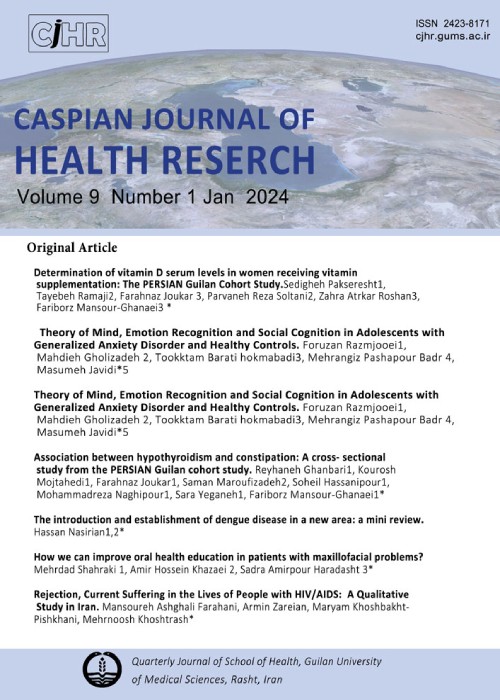فهرست مطالب
Caspian Journal of Health Research
Volume:5 Issue: 1, Mar 2020
- تاریخ انتشار: 1399/06/29
- تعداد عناوین: 5
-
-
Pages 3-7Background
Considering the complex conditions of work in rural environment, it is important to evaluate the quality of life and its relation with self-efficacy in health care providers
MethodsThis descriptive-analytical study was performed on 301 health care providers working in rural health centers. The short form of quality of life questionnaire (sf36) and Shererchr('39')s general self-efficacy scale was used to evaluate the study variables. Data were analyzed using ANOVA, independent t-test, Pearson correlation coefficient and linear regression.
ResultsThe average score of quality of life was 65.42 ± 19.1. Self-efficacy results showed that the mean self-efficacy score was 64.12 ± 10. According to multivariate linear regression method, there was significant inverse and independent relationship between quality of life with work duration (B = -0.45, P-value = 0.001) and income (B = -6.07, P-value = 0.001). There was no meaningful relationship between self-efficacy and quality of life in this study (B = -0.12, P-value = 0.33).
ConclusionThis study showed that work duration and income were important predictors of quality of life.
Keywords: Quality of Life, Self Efficacy, Health Care Providers, Rural Health Services -
Pages 8-11Background
Obesity is a global problem and is associated with pathophysiological mechanisms related to kidneys which may result in microalbuminuria. The aim of this study was to compare the microalbuminuria in obese and normal-weight children.
MethodsIn this descriptive analytical study, 200 children in two groups of obese and normal-weight investigated. Children who met the study criteria were enrolled and their age, gender and BMI were recorded. Then levels of urinary albumin and creatinine were measured and albumin-to-creatinine ratio were calculated. The two groups were compared using chi-square and t-test.
ResultsIn this study, 45% of obese children and 52% of normal children were boys. In terms of gender and age group, there was no significant difference between the two groups (P-value = 0.396 for gender and P-value =0.502 for age-group). The overall prevalence of microalbuminuria in the study population was 8.5%. The prevalence in obese children (13%) was more than normal-weight children (4%) (P-value=0.040). Further analysis stratified by sex and age-group showed a higher significant mean value of urine microalbuminuria in obese compared to normal-weight children among girls (P-value= 0.004) and among children in 12-19 years of age (P-value =0.033).
ConclusionThe results of this study showed that the obesity in children is associated with higher prevalence of microalbuminuria.
Keywords: Microalbuminuria, Children, Obesity -
Pages 12-16Background
Autism spectrum disorder (ASD) is a psychiatric disorder with a spectrum of symptoms, including impaired social interactions, impaired verbal and non-verbal communications, and limited and repetitive patterns of behaviors. The incidence of social and emotional disorders in siblings of an autistic child and relationship with having an autistic sibling is a matter of debate. The current study is aimed to assess the socio-behavioral development in the sibling of an autistic child (Sib-A).
MethodsThe current case-control study has been conducted on 51 Sib-A and 138 children without any autistic sibling (Sib-H). In order to assess social development, the Social Responsiveness Scale (SRS) that consists of 5 subscales of social awareness, social cognition, social communication, social motivation, and restricted interests and behavior was used. The behavioral status was assessed using the Strength and difficulties questionnaire (SDQ) in 5 subscales of emotional symptoms, conduct problems, hyperactivity, peer communications problems, and prosocial behaviors. Eventually, the findings of the two groups were compared.
ResultsThe mean score of SRS in cases was 43.35±36.84 and in controls 29.69 ± 11.20 (P-value = 0.012). Besides, the two groups were different in all subscales (P-value < 0.05) except social motivation (P-value = 0.1). The comparison of SDQ revealed a significant difference between the cases with a mean score of 5.93±5.53 and controls with 3.26 ± 2.57 (P-value = 0.011). Besides, the two groups were different in all subscales (P-value < 0.05) except for conduct problems (P-value = 0.1).
ConclusionThe siblings of autistic children showed more socio-behavioral problems than the controls. The genetically or nurturing of these problems should be investigated.
Keywords: Autism, Autism Spectrum Disorder, Siblings -
Pages 17-22Background
Plastic and cosmetic surgery is one of the most unique and less well-known surgical specialties. The aim of this study was to compare knowledge of medical students in pre-clinical and clinical course of Guilan University of Medical Sciences in the specialty field of plastic & cosmetic surgery.
MethodsThis cross-sectional study was conducted in educational hospitals of Guilan University of Medical Sciences. A total of 866 students in two groups of clinical and preclinical students were participated in the study. Research instrument was a questionnaire composed of 31 questions about knowledge toward plastic and cosmetic surgery including general, craniofacial, and cosmetic questions.
ResultsThe mean age of participants was 22.5 (SD = 2.5) and 57.2% were female. Twenty-four percent had a history of plastic and cosmetic surgery. Students in clinical course had significantly higher knowledge toward all three aspects of general, cosmetic and craniofacial questions compared to clinical students. The result of multivariate linear regression showed that the course level, sex, interest score to the field of surgery, and source of information were independently associated with knowledge.
ConclusionThis study found that clinical students had significantly higher knowledge toward the field of cosmetic surgery than pre-clinical students.
Keywords: Knowledge, Plastic Surgery, Medical Students


